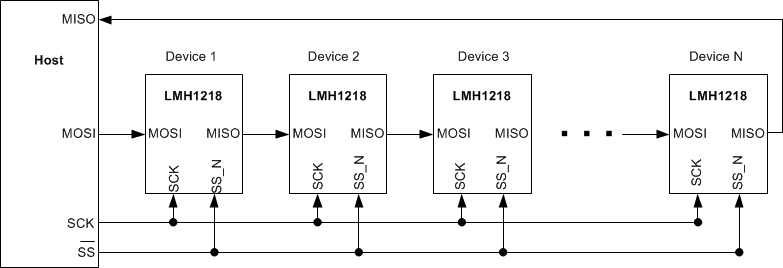SNLS474E February 2015 – June 2018 LMH1218
PRODUCTION DATA.
- 1 Features
- 2 Applications
- 3 Description
- 4 Revision History
- 5 Pin Configuration and Functions
- 6 Specifications
-
7 Detailed Description
- 7.1 Overview
- 7.2 Functional Block Diagram
- 7.3
Feature Description
- 7.3.1 Loss of Signal Detector
- 7.3.2 Continuous Time Linear Equalizer (CTLE)
- 7.3.3 2:1 Multiplexer
- 7.3.4 Clock and Data Recovery
- 7.3.5 Eye Opening Monitor (EOM)
- 7.3.6 Fast EOM
- 7.3.7 LMH1218 Device Configuration
- 7.3.8 Power-On Reset
- 7.4 Device Functional Modes
- 7.5 Programming
- 7.6 Register Maps
- 8 Application and Implementation
- 9 Power Supply Recommendations
- 10Layout
- 11Device and Documentation Support
- 12Mechanical, Packaging, and Orderable Information
Package Options
Mechanical Data (Package|Pins)
- RTW|24
Thermal pad, mechanical data (Package|Pins)
- RTW|24
Orderable Information
7.3.7.8 SPI Daisy Chain
The LMH1218 includes an enhanced SPI controller that supports daisy-chaining the serial configuration data among multiple LMH1218 devices. The LMH1218 device supports SPI Daisy Chain between devices with an 8-bit SPI addressing scheme. Each LMH1218 device is directly connected to the SCK and SS_N pins of the Host. However, only the first LMH1218 device in the chain is connected to the Host’s MOSI pin, and only the last device in the chain is connected to the Host’s MISO pin. The MOSI pin of each intermediate LMH1218 device in the chain is connected to the MISO pin of the previous LMH1218 device, thereby creating a serial shift register. This architecture is shown in Figure 18:
 Figure 18. Daisy-Chain Configuration
Figure 18. Daisy-Chain Configuration
In a daisy-chain configuration of N LMH1218 devices, the Host conceptually sees a long shift register of length 17xN. Therefore the length of a Basic SPI Transaction, as described above, is 17xN; in other words, SS_N is asserted for 17xN clock cycles.